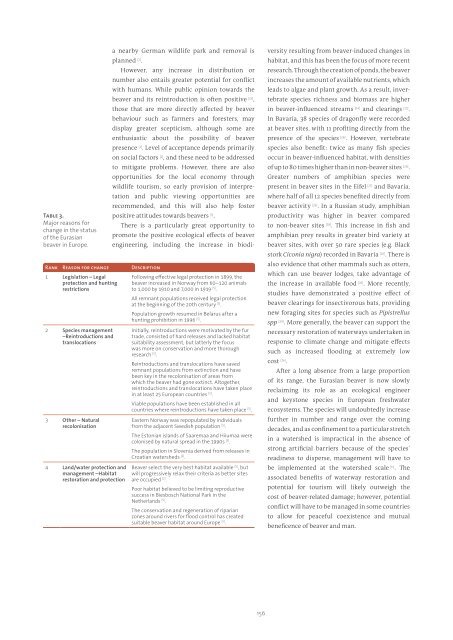130925-studie-wildlife-comeback-in-europe
Create successful ePaper yourself
Turn your PDF publications into a flip-book with our unique Google optimized e-Paper software.
Table 3.<br />
Major reasons for<br />
change <strong>in</strong> the status<br />
of the Eurasian<br />
beaver <strong>in</strong> Europe.<br />
a nearby German <strong>wildlife</strong> park and removal is<br />
planned [2] .<br />
Rank Reason for change Description<br />
1 Legislation – Legal<br />
protection and hunt<strong>in</strong>g<br />
restrictions<br />
2 Species management<br />
–Re<strong>in</strong>troductions and<br />
translocations<br />
3 Other – Natural<br />
recolonisation<br />
4 Land/water protection and<br />
management –Habitat<br />
restoration and protection<br />
However, any <strong>in</strong>crease <strong>in</strong> distribution or<br />
Follow<strong>in</strong>g effective legal protection <strong>in</strong> 1899, the<br />
beaver <strong>in</strong>creased <strong>in</strong> Norway from 60–120 animals<br />
to 1,000 by 1910 and 7,000 <strong>in</strong> 1919 [5] .<br />
All remnant populations received legal protection<br />
at the beg<strong>in</strong>n<strong>in</strong>g of the 20th century [5] .<br />
Population growth resumed <strong>in</strong> Belarus after a<br />
hunt<strong>in</strong>g prohibition <strong>in</strong> 1996 [5] .<br />
Initially, re<strong>in</strong>troductions were motivated by the fur<br />
trade, consisted of hard releases and lacked habitat<br />
suitability assessment, but latterly the focus<br />
was more on conservation and more thorough<br />
research [5] .<br />
Re<strong>in</strong>troductions and translocations have saved<br />
remnant populations from ext<strong>in</strong>ction and have<br />
been key <strong>in</strong> the recolonisation of areas from<br />
which the beaver had gone ext<strong>in</strong>ct. Altogether,<br />
re<strong>in</strong>troductions and translocations have taken place<br />
<strong>in</strong> at least 25 European countries [5] .<br />
Viable populations have been established <strong>in</strong> all<br />
countries where re<strong>in</strong>troductions have taken place [5] .<br />
Eastern Norway was repopulated by <strong>in</strong>dividuals<br />
from the adjacent Swedish population [5] .<br />
The Estonian islands of Saaremaa and Hiiumaa were<br />
colonised by natural spread <strong>in</strong> the 1990s [5] .<br />
The population <strong>in</strong> Slovenia derived from releases <strong>in</strong><br />
Croatian watersheds [2] .<br />
Beaver select the very best habitat available [5] , but<br />
will progressively relax their criteria as better sites<br />
are occupied [2] .<br />
Poor habitat believed to be limit<strong>in</strong>g reproductive<br />
success <strong>in</strong> Biesbosch National Park <strong>in</strong> the<br />
Netherlands [5] .<br />
The conservation and regeneration of riparian<br />
zones around rivers for flood control has created<br />
suitable beaver habitat around Europe [5] .<br />
number also entails greater potential for conflict<br />
with humans. While public op<strong>in</strong>ion towards the<br />
beaver and its re<strong>in</strong>troduction is often positive [23] ,<br />
those that are more directly affected by beaver<br />
behaviour such as farmers and foresters, may<br />
display greater scepticism, although some are<br />
enthusiastic about the possibility of beaver<br />
presence [2] . Level of acceptance depends primarily<br />
on social factors [2] , and these need to be addressed<br />
to mitigate problems. However, there are also<br />
opportunities for the local economy through<br />
<strong>wildlife</strong> tourism, so early provision of <strong>in</strong>terpretation<br />
and public view<strong>in</strong>g opportunities are<br />
recommended, and this will also help foster<br />
positive attitudes towards beavers [5] .<br />
There is a particularly great opportunity to<br />
promote the positive ecological effects of beaver<br />
eng<strong>in</strong>eer<strong>in</strong>g, <strong>in</strong>clud<strong>in</strong>g the <strong>in</strong>crease <strong>in</strong> biodiversity<br />
result<strong>in</strong>g from beaver-<strong>in</strong>duced changes <strong>in</strong><br />
habitat, and this has been the focus of more recent<br />
research. Through the creation of ponds, the beaver<br />
<strong>in</strong>creases the amount of available nutrients, which<br />
leads to algae and plant growth. As a result, <strong>in</strong>vertebrate<br />
species richness and biomass are higher<br />
<strong>in</strong> beaver-<strong>in</strong>fluenced streams [24] and clear<strong>in</strong>gs [25] .<br />
In Bavaria, 38 species of dragonfly were recorded<br />
at beaver sites, with 11 profit<strong>in</strong>g directly from the<br />
presence of the species [26] . However, vertebrate<br />
species also benefit: twice as many fish species<br />
occur <strong>in</strong> beaver-<strong>in</strong>fluenced habitat, with densities<br />
of up to 80 times higher than <strong>in</strong> non-beaver sites [26] .<br />
Greater numbers of amphibian species were<br />
present <strong>in</strong> beaver sites <strong>in</strong> the Eifel [27] and Bavaria,<br />
where half of all 12 species benefited directly from<br />
beaver activity [26] . In a Russian study, amphibian<br />
productivity was higher <strong>in</strong> beaver compared<br />
to non-beaver sites [28] . This <strong>in</strong>crease <strong>in</strong> fish and<br />
amphibian prey results <strong>in</strong> greater bird variety at<br />
beaver sites, with over 50 rare species (e.g. Black<br />
stork Ciconia nigra) recorded <strong>in</strong> Bavaria [26] . There is<br />
also evidence that other mammals such as otters,<br />
which can use beaver lodges, take advantage of<br />
the <strong>in</strong>crease <strong>in</strong> available food [26] . More recently,<br />
<strong>studie</strong>s have demonstrated a positive effect of<br />
beaver clear<strong>in</strong>gs for <strong>in</strong>sectivorous bats, provid<strong>in</strong>g<br />
new forag<strong>in</strong>g sites for species such as Pipistrellus<br />
spp [29] . More generally, the beaver can support the<br />
necessary restoration of waterways undertaken <strong>in</strong><br />
response to climate change and mitigate effects<br />
such as <strong>in</strong>creased flood<strong>in</strong>g at extremely low<br />
cost [26] .<br />
After a long absence from a large proportion<br />
of its range, the Eurasian beaver is now slowly<br />
reclaim<strong>in</strong>g its role as an ecological eng<strong>in</strong>eer<br />
and keystone species <strong>in</strong> European freshwater<br />
ecosystems. The species will undoubtedly <strong>in</strong>crease<br />
further <strong>in</strong> number and range over the com<strong>in</strong>g<br />
decades, and as conf<strong>in</strong>ement to a particular stretch<br />
<strong>in</strong> a watershed is impractical <strong>in</strong> the absence of<br />
strong artificial barriers because of the species’<br />
read<strong>in</strong>ess to disperse, management will have to<br />
be implemented at the watershed scale [11] . The<br />
associated benefits of waterway restoration and<br />
potential for tourism will likely outweigh the<br />
cost of beaver-related damage; however, potential<br />
conflict will have to be managed <strong>in</strong> some countries<br />
to allow for peaceful coexistence and mutual<br />
beneficence of beaver and man.<br />
156


